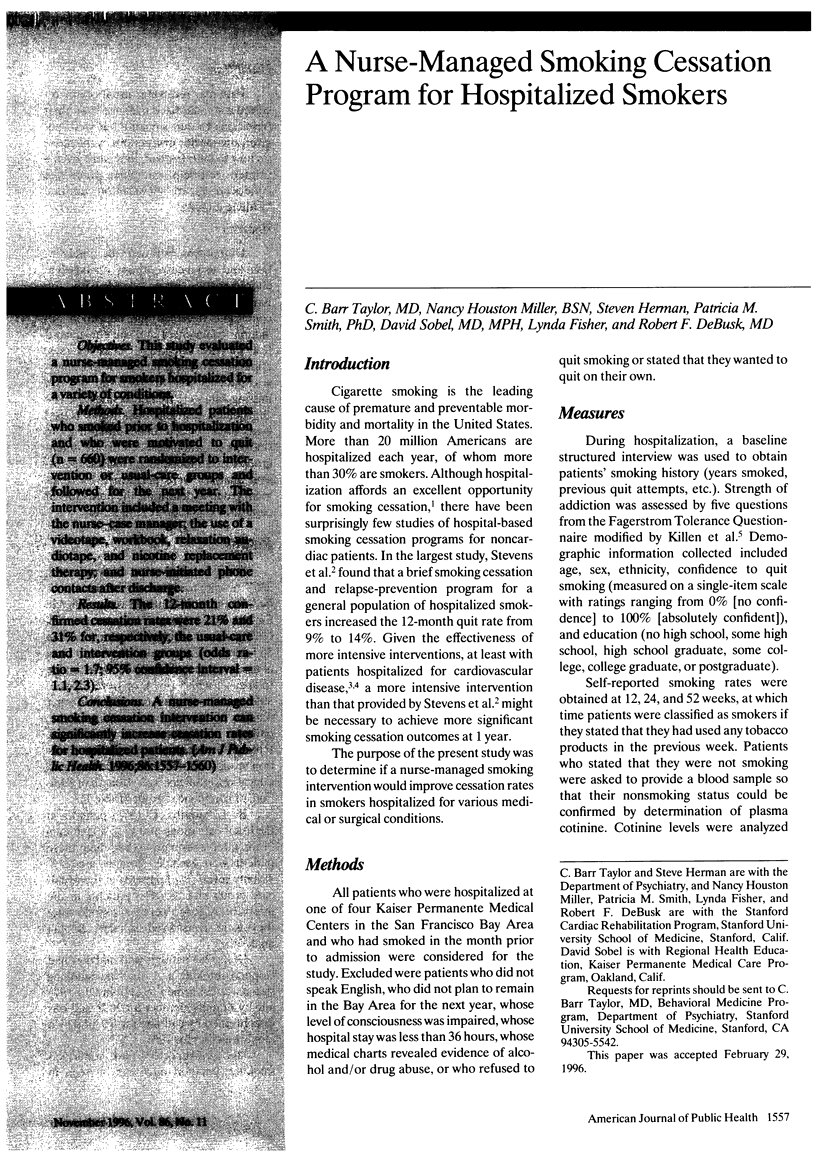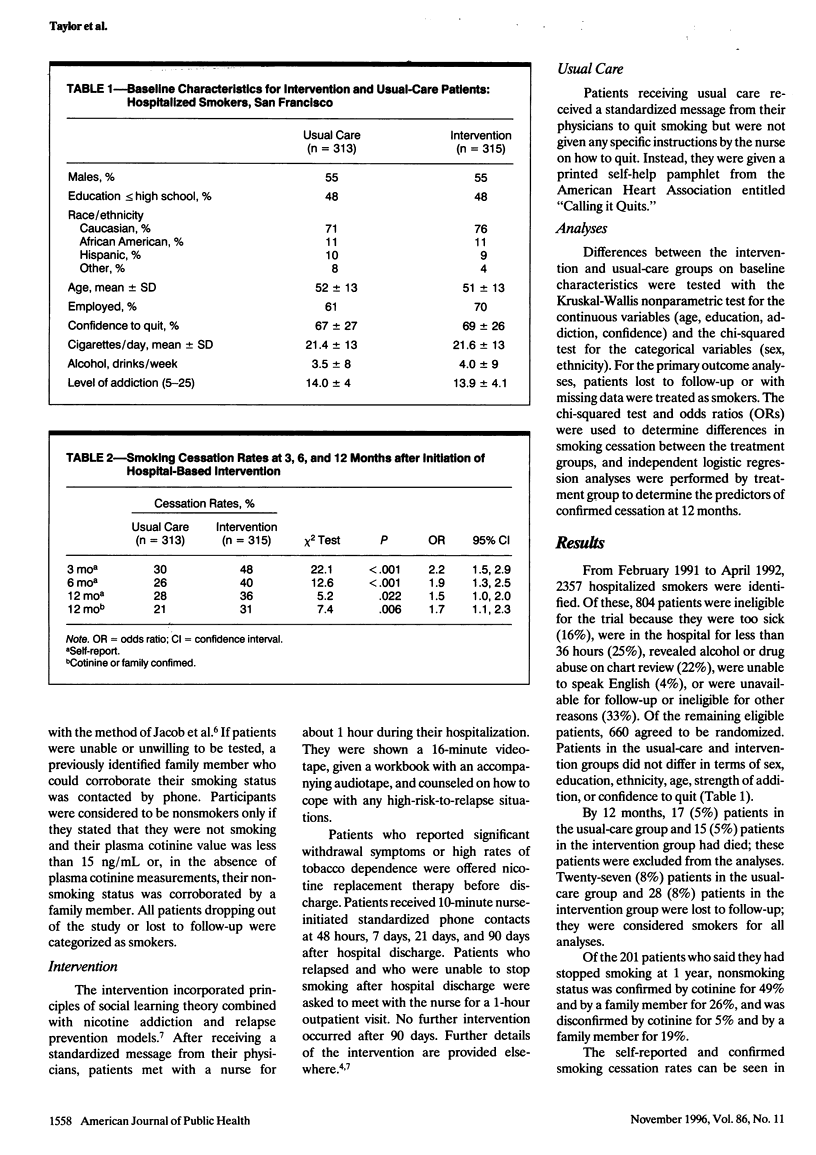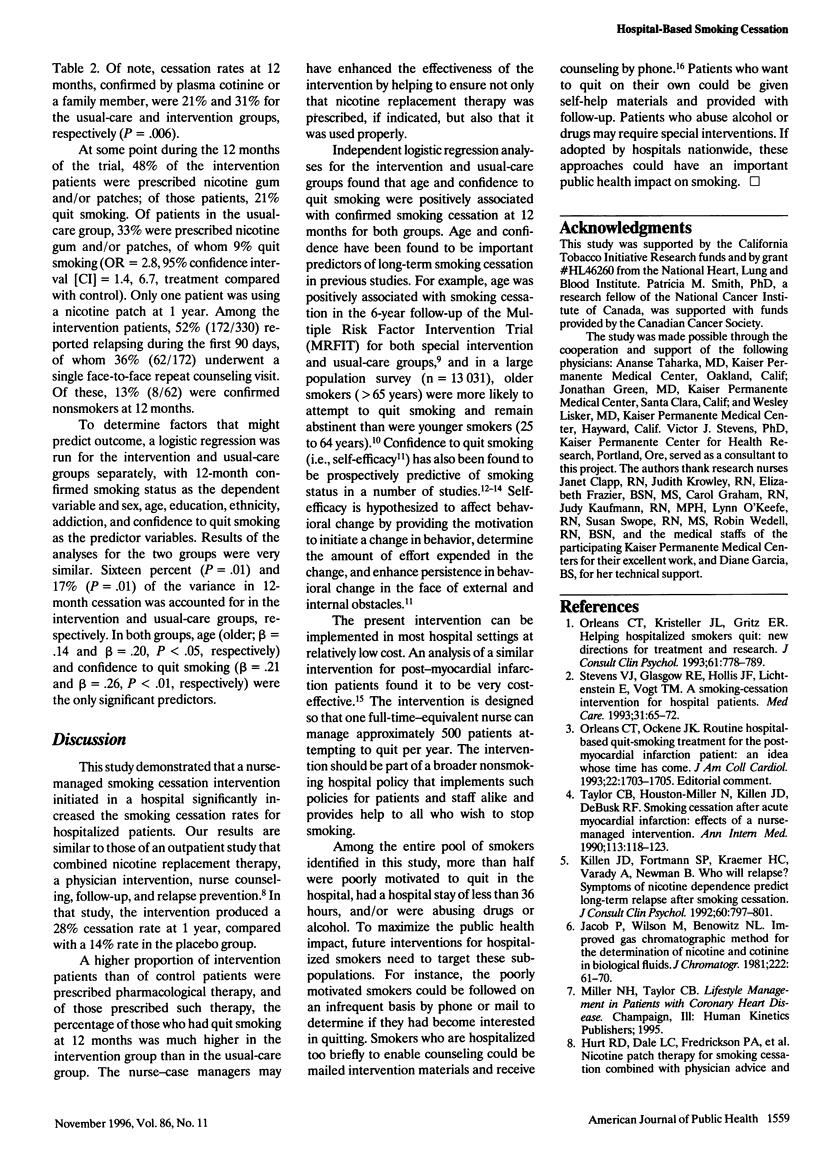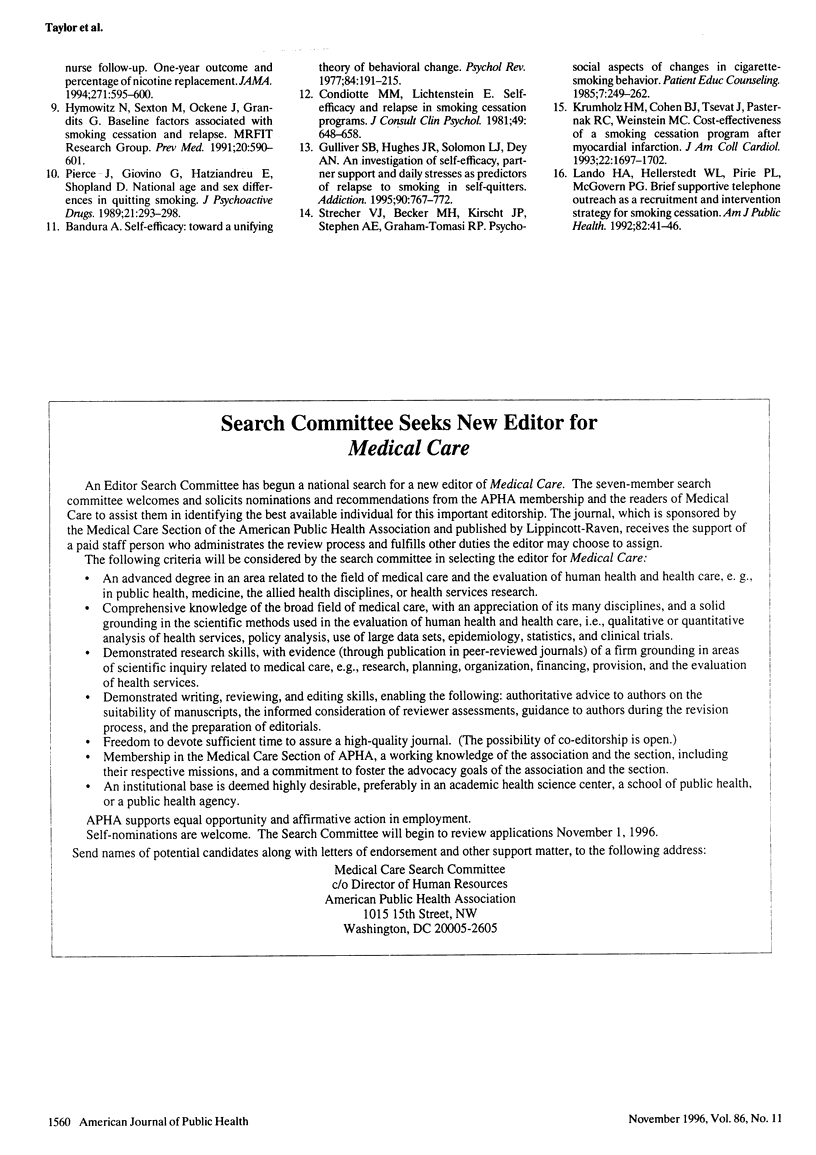Abstract
OBJECTIVES: This study evaluated a nurse-managed smoking cessation program for smokers hospitalized for a variety of conditions. METHODS: Hospitalized patients who smoked prior to hospitalization and who were motivated to quit (n = 660) were randomized to intervention or usual-care groups and followed for the next year. The intervention included a meeting with the nurse-case manager; the use of a videotape, workbook, relaxation audiotape, and nicotine replacement therapy; and nurse-initiated phone contacts after discharge. RESULTS: The 12-month confirmed cessation rates were 21% and 31% for, respectively, the usual-care and intervention groups (odds ratio = 1.7; 95% confidence interval = 1.1, 2.3). CONCLUSIONS: A nurse-managed smoking cessation intervention can significantly increase cessation rates for hospitalized patients.
Full text
PDF



Selected References
These references are in PubMed. This may not be the complete list of references from this article.
- Bandura A. Self-efficacy: toward a unifying theory of behavioral change. Psychol Rev. 1977 Mar;84(2):191–215. doi: 10.1037//0033-295x.84.2.191. [DOI] [PubMed] [Google Scholar]
- Condiotte M. M., Lichtenstein E. Self-efficacy and relapse in smoking cessation programs. J Consult Clin Psychol. 1981 Oct;49(5):648–658. doi: 10.1037//0022-006x.49.5.648. [DOI] [PubMed] [Google Scholar]
- Gulliver S. B., Hughes J. R., Solomon L. J., Dey A. N. An investigation of self-efficacy, partner support and daily stresses as predictors of relapse to smoking in self-quitters. Addiction. 1995 Jun;90(6):767–772. doi: 10.1046/j.1360-0443.1995.9067673.x. [DOI] [PubMed] [Google Scholar]
- Hymowitz N., Sexton M., Ockene J., Grandits G. Baseline factors associated with smoking cessation and relapse. MRFIT Research Group. Prev Med. 1991 Sep;20(5):590–601. doi: 10.1016/0091-7435(91)90057-b. [DOI] [PubMed] [Google Scholar]
- Jacob P., 3rd, Wilson M., Benowitz N. L. Improved gas chromatographic method for the determination of nicotine and cotinine in biologic fluids. J Chromatogr. 1981 Jan 2;222(1):61–70. doi: 10.1016/s0378-4347(00)81033-6. [DOI] [PubMed] [Google Scholar]
- Killen J. D., Fortmann S. P., Kraemer H. C., Varady A., Newman B. Who will relapse? Symptoms of nicotine dependence predict long-term relapse after smoking cessation. J Consult Clin Psychol. 1992 Oct;60(5):797–801. doi: 10.1037//0022-006x.60.5.797. [DOI] [PubMed] [Google Scholar]
- Krumholz H. M., Cohen B. J., Tsevat J., Pasternak R. C., Weinstein M. C. Cost-effectiveness of a smoking cessation program after myocardial infarction. J Am Coll Cardiol. 1993 Nov 15;22(6):1697–1702. doi: 10.1016/0735-1097(93)90598-u. [DOI] [PubMed] [Google Scholar]
- Lando H. A., Hellerstedt W. L., Pirie P. L., McGovern P. G. Brief supportive telephone outreach as a recruitment and intervention strategy for smoking cessation. Am J Public Health. 1992 Jan;82(1):41–46. doi: 10.2105/ajph.82.1.41. [DOI] [PMC free article] [PubMed] [Google Scholar]
- Orleans C. T., Kristeller J. L., Gritz E. R. Helping hospitalized smokers quit: new directions for treatment and research. J Consult Clin Psychol. 1993 Oct;61(5):778–789. doi: 10.1037//0022-006x.61.5.778. [DOI] [PubMed] [Google Scholar]
- Orleans C. T., Ockene J. K. Routine hospital-based quit-smoking treatment for the postmyocardial infarction patient: an idea whose time has come. J Am Coll Cardiol. 1993 Nov 15;22(6):1703–1705. doi: 10.1016/0735-1097(93)90599-v. [DOI] [PubMed] [Google Scholar]
- Pierce J., Giovino G., Hatziandreu E., Shopland D. National age and sex differences in quitting smoking. J Psychoactive Drugs. 1989 Jul-Sep;21(3):293–298. doi: 10.1080/02791072.1989.10472170. [DOI] [PubMed] [Google Scholar]
- Stevens V. J., Glasgow R. E., Hollis J. F., Lichtenstein E., Vogt T. M. A smoking-cessation intervention for hospital patients. Med Care. 1993 Jan;31(1):65–72. doi: 10.1097/00005650-199301000-00005. [DOI] [PubMed] [Google Scholar]
- Strecher V. J., Becker M. H., Kirscht J. P., Eraker S. A., Graham-Tomasi R. P. Psychosocial aspects of changes in cigarette-smoking behavior. Patient Educ Couns. 1985 Sep;7(3):249–262. doi: 10.1016/0738-3991(85)90033-3. [DOI] [PubMed] [Google Scholar]
- Taylor C. B., Houston-Miller N., Killen J. D., DeBusk R. F. Smoking cessation after acute myocardial infarction: effects of a nurse-managed intervention. Ann Intern Med. 1990 Jul 15;113(2):118–123. doi: 10.7326/0003-4819-113-2-118. [DOI] [PubMed] [Google Scholar]


